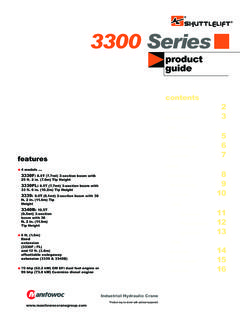Transcription of 089-2008: It's a Bird, It's a Plane, It's SQL Transpose!
1 SAS Global Forum 2008 Applications Development Paper 089-2008. It's a Bird, It's a Plane, It's SQL transpose ! Ted Conway, Chicago, IL. ABSTRACT. Ever wish you could easily transpose and summarize monthly data using just PROC SQL? Regardless of whether the data is stored in a SAS dataset or other relational databases? Even if scores of variables for dozen of months are involved? This paper tackles the task of data denormalization with a simple macro that uses PROC SQL to take a "vertical" table with multiple rows per subject and transform it into a "horizontal" table containing one row per subject with aggregated monthly values.
2 INTRODUCTION. Much to the chagrin of Data Modelers and DBAs everywhere, sometimes analysis and reporting is a lot easier with a one-row-per-subject table than a multiple-rows-per-subject table. On his Statistical Computing weblog, Wensui Liu describes three ways of converting a long table to a wide table using SAS: PROC transpose . PROC SQL. DATA STEP. Wensui's PROC SQL solution, repeated below, is a logically appealing technique that has the added bonus of being able to be used with SAS datasets as well as other relational databases: **. * METHOD 2: PROC SQL *. **;. proc sql;. create table wide2 as select id, sum(case when time = 1 then x else 0 end) as x1, sum(case when time = 2 then x else 0 end) as x2, sum(case when time = 3 then x else 0 end) as x3.
3 From long group by id;. While the above solution looks attractive, it loses some of its luster when you consider what you'd have to do to deal with more variables and time periods. For example, what if you had to deal with 36 months instead of the 3 time periods above? And what if you were dealing with 200 variables instead of the 1 column above? That, my friend, is where the LONG2 WIDE macro comes in! LONG2 WIDE MACRO SAMPLE USAGE. Before looking at the guts of the LONG2 WIDE macro, let's first take a look at how one might use it: %long2wide(data= , by=product, months=month jan1993-dec1994, vars=actual predict, out=prdsalesum).
4 In the above example, the data keyword parameter is used to specify the input SAS data set ( , which is provided with Base SAS). The by parameter is used to specify the level of summarization in this instance, we want to create one row at the product level. The months parameter is used to specify the name of the variable containing the date value (month in this example), as well as a list of individual month values (or hyphen-separated ranges) that are to be summarized and transposed. The vars parameter is used to list the variables that are to be transposed and summarized. The final parameter, out, is used to specify the name of the output dataset that will hold the output dataset.
5 Here, prdsalesum will contain variables product, actuall199301-actual199412 and predict199301-predict199412. We've been able to denormalize the data into a new flat structure containing 49 variables with a mere three lines of code! 1. SAS Global Forum 2008 Applications Development LONG2 WIDE MACRO SAMPLE INPUT LONG2 WIDE MACRO SAMPLE OUTPUT 2. SAS Global Forum 2008 Applications Development LONG2 WIDE MACRO CODE. %macro long2wide(data=_last_, by=, months=, vars=, out=_data_);. proc sql;. create table &out as select &by %let dv=%scan(&months,1);. %let i=1;. %let v=%scan( . %do %while(" . %let j=2;. %let mo=%scan(&months,2," ").))
6 %do %while(" . %let lmo="01%scan(&mo,1,"-")"d;. %let hmo="01%scan(&mo,2,"-")"d;. %if &hmo="01"d %then %let hmo= . %let nmo=%sysfunc(intck(month,&lmo, . %do m2=0 %to . %let mo1=%sysfunc(intnx(month,&lmo,&m2),date9 .);. %let mo2=%sysfunc(intnx(month,&lmo,&m2),yymmn 6.);. , sum(case when &dv="&mo1"d then &v end) as &v&mo2. %end;. %let j=%eval( . %let mo=%scan(&months, . %end;. %let i=%eval( . %let v=%scan( . %end;. from &data group by &by order by . %mend;. LONG2 WIDE MACRO SAMPLE MACRO INVOCATION. %long2wide(data= , by=product, months=month jan1993-dec1994, vars=actual predict, out=prdsalesum);. LONG2 WIDE MACRO SAMPLE DESIRED TRANSFORMATION.)))))))
7 MONTH PRODUCT ACTUAL PREDICT. 1993-01 BED $31 $29. 1993-02 BED $40 $39. 1993-03 BED $50 $40. 1993-01 CHAIR $76 $65. 1993-02 CHAIR $78 $72. 1993-03 CHAIR $90 $92. PRODUCT ACTUAL199301 ACTUAL199302 ACTUAL199303 PREDICT199301 PREDICT199302 PREDICT199303. BED $31 $40 $50 $29 $39 $40. CHAIR $76 $78 $90 $65 $72 $92. 3. SAS Global Forum 2008 Applications Development LONG2 WIDE MACRO SAMPLE GENERATED SAS CODE. proc sql;. create table prdsalesum as select product , sum(case when month="01 JAN1993"d then actual end) as actual199301 , sum(case when month="01 FEB1993"d then actual end) as actual199302 , sum(case when month="01 MAR1993"d then actual end) as actual199303 , sum(case when month="01 APR1993"d then actual end) as actual199304 , sum(case when month="01 MAY1993"d then actual end) as actual199305 , sum(case when month="01 JUN1993"d then actual end) as actual199306 , sum(case when month="01 JUL1993"d then actual end) as actual199307 , sum(case when month="01 AUG1993"d then actual end)
8 As actual199308 , sum(case when month="01 SEP1993"d then actual end) as actual199309 , sum(case when month="01 OCT1993"d then actual end) as actual199310 , sum(case when month="01 NOV1993"d then actual end) as actual199311 , sum(case when month="01 DEC1993"d then actual end) as actual199312 , sum(case when month="01 JAN1994"d then actual end) as actual199401 , sum(case when month="01 FEB1994"d then actual end) as actual199402 , sum(case when month="01 MAR1994"d then actual end) as actual199403 , sum(case when month="01 APR1994"d then actual end) as actual199404 , sum(case when month="01 MAY1994"d then actual end) as actual199405 , sum(case when month="01 JUN1994"d then actual end) as actual199406 , sum(case when month="01 JUL1994"d then actual end) as actual199407 , sum(case when month="01 AUG1994"d then actual end) as actual199408 , sum(case when month="01 SEP1994"d then actual end) as actual199409 , sum(case when month="01 OCT1994"d then actual end) as actual199410 , sum(case when month="01 NOV1994"d then actual end) as actual199411 , sum(case when month="01 DEC1994"d then actual end) as actual199412 , sum(case when month="01 JAN1993"d then predict end) as predict199301 , sum(case when month="01 FEB1993"d then predict end)
9 As predict199302 , sum(case when month="01 MAR1993"d then predict end) as predict199303 , sum(case when month="01 APR1993"d then predict end) as predict199304 , sum(case when month="01 MAY1993"d then predict end) as predict199305 , sum(case when month="01 JUN1993"d then predict end) as predict199306 , sum(case when month="01 JUL1993"d then predict end) as predict199307 , sum(case when month="01 AUG1993"d then predict end) as predict199308 , sum(case when month="01 SEP1993"d then predict end) as predict199309 , sum(case when month="01 OCT1993"d then predict end) as predict199310 , sum(case when month="01 NOV1993"d then predict end) as predict199311 , sum(case when month="01 DEC1993"d then predict end) as predict199312 , sum(case when month="01 JAN1994"d then predict end) as predict199401 , sum(case when month="01 FEB1994"d then predict end) as predict199402 , sum(case when month="01 MAR1994"d then predict end) as predict199403 , sum(case when month="01 APR1994"d then predict end) as predict199404 , sum(case when month="01 MAY1994"d then predict end) as predict199405 , sum(case when month="01 JUN1994"d then predict end)
10 As predict199406 , sum(case when month="01 JUL1994"d then predict end) as predict199407 , sum(case when month="01 AUG1994"d then predict end) as predict199408 , sum(case when month="01 SEP1994"d then predict end) as predict199409 , sum(case when month="01 OCT1994"d then predict end) as predict199410 , sum(case when month="01 NOV1994"d then predict end) as predict199411 , sum(case when month="01 DEC1994"d then predict end) as predict199412. FROM GROUP BY PRODUCT ORDER BY PRODUCT;. Imagine how fun it would be to hand-code this for two hundred variables instead of two! 4. SAS Global Forum 2008 Applications Development CONCLUSION.












